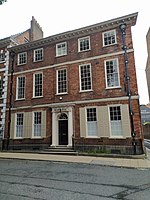York railway station (1841)
1841 establishments in England1877 disestablishments in EnglandDisused railway stations in North YorkshireFormer North Eastern Railway (UK) stationsFormer York and North Midland Railway stations ... and 6 more
George Townsend Andrews railway stationsGrade II* listed buildings in YorkGrade II* listed railway stationsRailway stations in Great Britain closed in 1877Railway stations in Great Britain opened in 1841Use British English from November 2022

The former York railway station served the city of York, England between 1841 and 1877. It is a Grade II* listed building.
Excerpt from the Wikipedia article York railway station (1841) (License: CC BY-SA 3.0, Authors, Images).York railway station (1841)
Station Rise, York Bishophill
Geographical coordinates (GPS) Address Nearby Places Show on map
Geographical coordinates (GPS)
| Latitude | Longitude |
|---|---|
| N 53.9583 ° | E -1.0894 ° |
Address
City of York Council
Station Rise
YO1 6GA York, Bishophill
England, United Kingdom
Open on Google Maps











